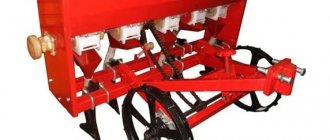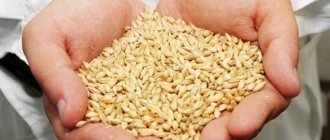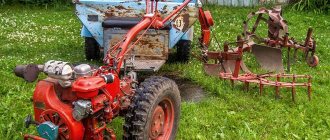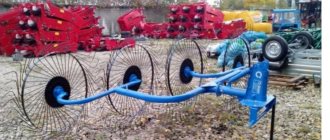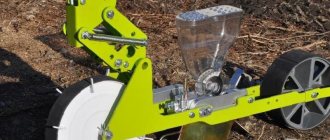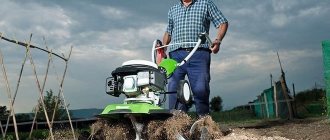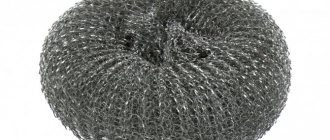A modern seeder on a walk-behind tractor is a device that allows you to plant seeds of garlic, onions, corn and other crops, saving the farmer’s time and effort.
The design of the seeder is quite simple, which allows you to make it yourself. Let’s talk in more detail about what is required for this and how to make the equipment yourself.
Classification of walk-behind seeders
At the moment, walk-behind tractors of various types are produced, depending on specific economic needs. Based on the type of seed application, the following types of equipment are distinguished:
- Nesting. When sowing in rows, seeds are placed in nests.
- Privates. With row sowing, simultaneous seeding is also carried out.
- Dotted or precision seeding. Seed placement occurs in one row and at even intervals when sowing in a wide row.
- Square-nested. Using this equipment, it is possible to sow seeds in pre-marked squares or rectangles.
- Scattered. The equipment is designed to scatter seed material over the entire sown area.
Also, seeders can differ in sowing crops or be completely universal. Universal seeders can be used for sowing both vegetable and grain crops. It is worth mentioning precision seeders, which are distinguished by a brush sowing device that guarantees the introduction of a certain amount of seeds into the soil.
In addition to the main technical characteristics, it is worth paying attention to the number of rows that can be sown. And if the equipment installed on conventional tractors can process up to twelve rows, then seeders for walk-behind tractors can sow no more than five.
How to make a seeder for a walk-behind tractor with your own hands?
To make a homemade seeder for your existing walk-behind tractor balanced and multifunctional, you should strictly adhere to a certain scheme. The drawings used should promptly indicate the dimensions of the parts and how to install them in the overall structure.
After studying the drawings, you should proceed directly to assembling the equipment yourself:
- First you need to make a frame. It can be made from pipes or iron strips welded to each other in the shape of the letter U;
- A hopper should be installed on top of the frame and secured with bolts;
- Inside the bunker you need to place a mechanism for sowing, which will need to be installed on 2 sliding bearings;
- Next, you need to take a pipe that will act as an axis and place 3 intact disks on it. The latter must be installed at the same distance;
- Next, in each of the disks you need to drill 12 holes into which the planted seeds will be placed. As the seeder moves, the discs will pass through the hopper, and the seeds will fall into the holes, after which the discs will direct them into the furrows preset opposite the discs;
- A special bar should be installed in the back of the manufactured frame, which will embed the seeds into the soil;
- You need to attach 3 wheels to the bottom of the frame. The video will tell you more about assembling the seeder on a walk-behind tractor.
While using a homemade seeder, the sowing mechanism coil will rotate under the action of the bicycle chain. This will make the discs with the holes move. In this case, the seeds, after falling into the previously made holes, will be transported into the furrows, after which they will begin to fall into the ground. At the same time, the bar located at the back will embed the seed into the soil.
Seeder on a walk-behind tractor - a more complex method of making it yourself
This assembly option involves the manufacture of a dotted seeder for the walk-behind tractor used on the farm.
At the same time, a homemade precision seeder for a walk-behind tractor must certainly consist of a list of the following elements:
- seed hopper:
- 2 bearings;
- 2 running wheels;
- 2 brackets fixing the opener;
- handles equipped with a bracket.
The algorithm for assembling a seeder for a walk-behind tractor looks like this:
- First you need to make a seed hopper. To make it, you should use boards with a thickness of 1.5 cm. The bottom of the bunker can be made from a plank 1 cm thick. The longitudinal and transverse walls of the bunker will need to be fastened together with metal corners, tenons and screws. Directly at the bottom of the walls of the manufactured bunker it is necessary to install special wooden pads attached with screws or nails;
- You will need to make holes in the walls and linings of the hopper to mount the seed roller. After this, the mounting brackets are screwed to the linings using screws;
- The wheels of a homemade seeder must be attached using hubs. The diameter of the wheels used should not exceed 20 cm. Before installation, holes will need to be made in the hubs, the diameter of which must be the same as the diameter of the seed roller used;
- The opener must be secured to the brackets using a steel sheet 1.5 mm thick. You also need to make a couple of holes on the bracket;
- To attach the hopper to the walk-behind tractor, attach a bracket to the rear wall of the hopper.
Planting garlic with a walk-behind tractor with a manufactured seeder will allow for more accurate sowing of prepared seeds, placing them exactly within the furrows made. Such a device has high productivity, endurance and can serve on the farm for more than one year.
Premium STV-2
The motor-block double-row seeder of the Premium series - STV-2 is designed for introducing into the soil seeds of corn, garlic and other vegetable and grain crops, of various fractions, in pre-prepared areas. This model simultaneously cuts furrows, introduces seed material and embeds it into the soil, and also compacts the rows. The seeder can be installed on walk-behind tractors with a power of 6 hp or more.
Seeder STV-2
Specifications
What kind of seeders are there?
It can be divided according to the type of planting crops and productivity. So, there are simple single-row models, they are quite simple, affordable, and if you do not need to buy more advanced models and there is not a lot of land, then it will be enough for you.
Multi-row ones are more productive, these are models with two rows or more, they are worth choosing if you have a powerful machine to install them, since they have more weight and the load will naturally also be higher. It will depend on your area where you need to carry out work; if the field is huge or there are simply a lot of vegetable gardens, then becoming the owner of a multi-row device, you will save time.
And according to the type of equipment, the material to be sown can be divided into grains (various), and vegetable, flower and other seeds or planting garlic in the form of cloves, etc., each type may require its own peculiarity of introducing them into the soil layer , some are not demanding and are not afraid of simple throwing, while others need delicacy so as not to damage them.
This agricultural canopy can be purchased with delivery in Moscow, Tula, St. Petersburg, Belgorod, Krasnodar, Pskov, Veliky Novgorod, Petrozavodsk, Vologda, Arkhangelsk. We work with trusted suppliers and guarantee the quality of our products.
STV-4
The STV-4 precision seed drill is used to add seeds of various grain and vegetable crops to the soil. Depending on the fraction of planting material, various replaceable drums can be used, which come as standard equipment in the amount of 2 pieces. The seeder can simultaneously lay a furrow, introduce and embed seeds, and then compact the soil. The equipment is driven by a chain transmission from lugs. The seeder can be installed on walk-behind tractors with power from 6 hp.
Precision seeder STV-4
Specifications
Mounted seeders
Tilling the land is, of course, a necessary activity and you can’t go anywhere without it, but after plowing, applying fertilizers and other manipulations, it’s time to take care of the future harvest!
Effective equipment in the form of seeders comes to the aid of any farmer and not only that, which will allow you to sow a variety of grain crops! You no longer need to use mechanical seed sowers or even manually add them to the soil from a container, especially since the productivity of such methods is very low! And what can we say about uniformity, it is impossible to ensure the normal distribution of grains or other planting material by introducing them into the soil “by eye”. Such devices are placed on a walk-behind tractor or a mini-tractor, depending on what you own, and will help you sow any vegetable garden or giant field as quickly as possible, you just need to drive from one end to the other and make sure that the seeding container is not empty.
The ability to plant completely different vegetables or grains in the form of seeds makes them one of the most desirable purchases, along with attachments for soil cultivation. You can grow wheat, beets, and even tomatoes and much more, whatever your heart desires and the situation and climate allows. And such functions as precise adjustment of depth and planting density significantly expand the farmer’s choice and the ability to select the necessary parameters for work.
SM-6
The seeder for the SM-6 walk-behind tractor is designed specifically for the seed application of small-seeded vegetable and grain crops in greenhouses, small farms and personal plots. This equipment can perform uniform six-row sowing of vegetable, grain and herb seeds.
Seeder SM-6
Using the CM-6 seeder, it is possible to sow crops such as peppers, garlic and peas, radishes and beets, parsley and dill, carrots and tomatoes, sweet clover and spinach, and many others.
Uniformity and precision of seed application into the soil is achieved thanks to the ability to adjust the depth and sowing rate. When sowing fine seeds, they should be mixed with a filler, which can be bran, cereals or roasted seeds of various plants, but the use of river sand is strictly not recommended.
The CM-6 seeder can be aggregated with medium and heavy walk-behind tractors, and can also be used in one of three ways:
- using a PNO adapter (recommended for unfenced land plots with an area of over 10 acres);
- using one walk-behind tractor (recommended for use in fenced areas of up to 10 acres);
- using manual traction (when processing fenced areas of up to 5 acres, as well as in greenhouses).
Specifications
Features of application
The basic principle of operation of the simplest sowing mechanism is to limit the spilling of seeds out. An open box with a double good bottom is used for this procedure. A movable plate is inserted into the formed space.
Grains or seeds are poured into the bottom of the box (upper) with holes slightly larger than the size of the planting material; in the lower tier of the mechanism there are larger holes, they coincide with the top.
When pushing in the middle intermediate plate, the holes in the bottoms do not communicate, which means the grains do not spill out. If the valve is moved, the sower will start working again.
To avoid thickening of the crops, you should not pour a large number of seeds into the structure at once, rolling them over the mechanism.
Many vegetable growers equip the movable (middle) plate with a spring, which facilitates the operational process.
Using the landing mechanism is very simple. A furrow is marked in the garden bed. They place a homemade seeder on it and move the device forward. The tank begins to rotate - grain or seeds are poured out evenly. Then, using an improvised hoe, the plantings are covered with loose soil.
The seeds are fixed in the seeder using a transparent plastic tank.
The entire structure can be easily converted for any vegetable crop; for example, in a radish seeder, the holes in the tank need to be made smaller than in a mechanism for planting corn.
It is very easy to make improvised parts using simple materials. For economical and high-quality planting of various vegetable crops, it is necessary to make about 3-4 tanks for the seeder with holes of different sizes.
By using a mechanism for planting small seeds, sowing can be accelerated 10 times. As an example of a simple hand-held device, consider a carrot seeder.
To make it you will need the following materials:
- Plastic or metal shaft. You can use a part from a thick-walled pipe.
- A wheel made from a tin can (a small bicycle wheel will do).
- A bunker made from a plastic bottle, container, or shampoo container.
- Retaining rings designed for the wheel.
- Foam rubber.
- Transport bracket (1 piece).
- Wooden handle.
- Screw “M 4” (from 4 to 8 pcs.).
- Restrictive rings/clamps (from 2 to 4 pcs.).
- Nut “M 4” (from 4 to 8 pcs.).
For high-quality assembly you will need tools: a screwdriver, drills with different diameters, scissors, a drill, a knife.
The process of manufacturing a simple manual seeder takes place in several stages:
- The shaft is being prepared. In the middle of the plastic pipe, recesses of different diameters are drilled (for large and small seeds). The pipe is not drilled through.
- Wheels are made from tin cans. To ensure better grip, rubber rings are placed on the wheels in several rows. In the middle, using scissors, a hole is cut equal to the diameter of the shaft.
- A hopper is cut out of a plastic container. The lower part is cut off, holes are made on the opposite walls for the sowing shaft. The bottle is placed upside down.
- The hopper is placed on the shaft. Foam rubber is laid and glued to the bottle walls so that during further rotation the excess seeds are removed. That is, when the foam brush is turned, the shaft should produce small cells, each of which will contain one or two seeds.
- The transport bracket is attached to the shaft with wheels and secured with screws.
- The hopper is carefully attached through a metal plate to the bracket. When the shaft rotates, it should not move.
- A wooden handle is installed.
The simple design will significantly reduce labor costs. This is how you make a manual seeder with your own hands. The main disadvantage of this mechanism is the limited sowing (only in 1 row) and the sowing of only one vegetable crop due to the different size of the seeds. The problem can be solved by using several replacement cans with different holes.
Much more complicated is a self-made sowing device, with which you can work with seeds of different crops. The main working mechanism in the universal design is the sowing shaft, which is an aluminum tube with a diameter of 30 mm. Holes are drilled in three rows of different sizes. Each line is made for one crop.
SVTV 4-8
The SVTV 4-8 vacuum walk-behind seeder is designed for precision sowing of vegetable crops, garlic, and grains. The basic configuration has 4 rows, but if necessary, it can be expanded to 8 rows. This equipment allows you to achieve more accurate seeding compared to pneumatic units. The seeder can be used with both heavy walk-behind tractors and mini-tractors.
Vacuum seeder SVTV 4-8
Specifications
Share
Principle of operation
A typical seeder feeds the seed into the seed meter, places the seed in the soil at the desired depth and equal distance from the previous one, and, using a complex seeding mechanism, completes the sowing process.
The pneumatic seeding mechanism usually consists of: a clod remover, a wedge point on a skid opener, a seed furrow filler and a compaction wheel.
If the seeder can be used directly on mulch or unprepared soil, then special discs are placed in front of the coulter to cut crop residues and create landing slots for the smooth entry of the skid coulter.
Sometimes such units can be equipped with additional devices for localized application of fertilizers with a diameter (and depth) of 5 cm from the seed. This method of fertilizing greatly helps to accelerate the development of corn at the stage of the first phenological phases.
Sowing with fertilizer application
A universal method of sowing at high speeds of movement of the seeder across the field, without compromising the tracking of seeding rates, seed placement depth, and even with the ability to place seeds in the soil in a checkerboard pattern, is achieved using seeders equipped with GPS devices.
They can sow and apply fertilizer without compromising precision and quality at speeds of 8 to 10 km/h thanks to the fact that they are additionally equipped with the appropriate electronic system and drive system (hydraulic and electric).
